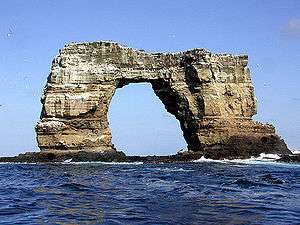Darwin's Arch

Darwin's Arch is a natural rock arch feature situated to the southeast of Darwin Island in the Pacific Ocean. The arch sits on an irregularly shaped, rocky, submerged plateau, nicknamed "the theatre".[1][2]
Geography

Part of the Galápagos archipelago, Darwin Island is a small, uninhabited island with an area of 2.33 square kilometres (0.90 sq mi) and an elevation of 168 metres (551 ft). Darwin's Arch is situated 1 kilometre (0.62 mi) to the southeast of the island and has a bridge-like appearance, which has been caused by erosion.[3] The plateau's wall drops away into the sea, and the arch's ocean side features a "viewing platform" at 18 metres (59 ft).[4]
Fauna
From its southern end to the sloping channel, the marine fauna seen are scalloped hammerheads, manta rays, big-eye jacks, bonito, yellowfin tuna, dolphins, big schooling of species of pelagic fish, and also whale sharks of up to 14 metres (45 ft) in length. The whale sharks are found from early July.[1][2] Other marine fauna include Moorish idols, Galapagos sharks, eagle rays, green turtles, and Hawksbill turtles, silkie and white tipped reef sharks, barracuda and black jack sharks.[4][5] Many birds are endemic and the species commonly noted is the sooty tern (Sterna fuscata), which breeds on Darwin Island.[1]
References
- 1 2 3 "Darwin". Galapagos Conservancy. Retrieved 19 June 2015.
- 1 2 Steve Rosenberg; Ellen I. Sarbone (April 2004). The Diving Guide Galapagos Islands. Cruising Guide Publications, Incorporated. ISBN 978-0-944428-70-2.
- ↑ Harpp, Mittelstaedt & d'Ozouville 2014, p. 311.
- 1 2 Jackson & Schuster 2008, p. 221.
- ↑ Sport Diver. January 2001. p. 110. ISSN 1077-985X.
Coordinates: 1°40′17.2″N 91°59′26.0″W / 1.671444°N 91.990556°W
Bibliography
- Dixon, Charles (1900). The Story of the Birds. G. Allen. pp. 240–.
- Harpp, Karen S.; Mittelstaedt, Eric; d'Ozouville, Noémi; David W. Graham (22 July 2014). The Galapagos: A Natural Laboratory for the Earth Sciences. Wiley. ISBN 978-1-118-85268-2.
- Jackson, Jack; Schuster, Simon & (September 2008). Dive Atlas of the World. New Holland Publishers. ISBN 978-1-84773-317-7.
External links
